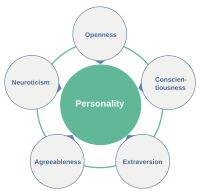
Photo from wikipedia
Introgressive breeding to introduce both obvious variation into a gene pool, and to unmask cryptic variation masked by close linkage or epistatic interactions, has repeatedly been attempted to improve fiber… Click to show full abstract
Introgressive breeding to introduce both obvious variation into a gene pool, and to unmask cryptic variation masked by close linkage or epistatic interactions, has repeatedly been attempted to improve fiber traits in Gossypium hirsutum by employing Gossypium barbadense as a donor parent. This study reports genetic variation for fiber quality traits in reciprocal advanced backcross populations between G. hirsutum cultivar Acala Maxxa and G. barbadense cultivar Pima S6. Micronaire (MIC), elongation (ELO), strength (STR), upper half mean length (UHM), and uniformity index (UI) showed significant genotypic variance, albeit different in the respective backgrounds for all traits except UI. Different levels of variation among genotypes for the same traits in reciprocal backgrounds suggest different levels of epistatic interactions, a hypothesis supported by a significant difference in transgressive segregants in Acala Maxxa and Pima S6 backgrounds. In Acala Maxxa background, 18, 18, 7, and 3 genotypes had significantly better MIC, ELO, STR and UHM, respectively, than Acala Maxxa. In Pima S6 background 10, 5, 8, and 11 genotypes had significantly better MIC, ELO, STR, and UHM, respectively, than Pima S6. Increased genetic variation and improved fiber quality in both backgrounds appears attainable using reciprocal introgression; however, the number of genotypes with simultaneous improvement for multiple fiber quality traits was higher in Acala Maxxa than Pima S6 background. Reciprocal populations provide a platform to study cytoplasmic effects on genetic variation and heritability of fiber quality traits, and estimate the size of base populations required to obtain genotypes with genetic gain by backcross breeding.
Journal Title: Euphytica
Year Published: 2017
Link to full text (if available)
Share on Social Media: Sign Up to like & get
recommendations!